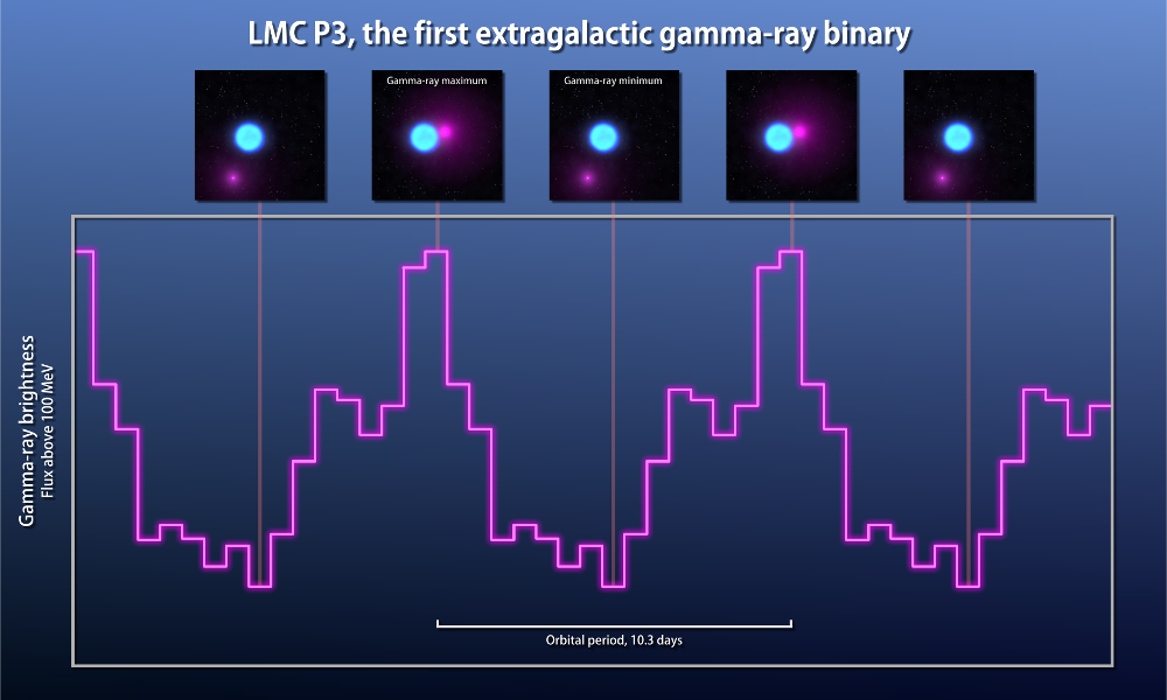
 Credit: NASA's Goddard Space Flight Center; R. Corbet et al., 2016
Credit: NASA's Goddard Space Flight Center; R. Corbet et al., 2016
Extreme Outsider
Many, perhaps most, stars live as binary systems, in which two (sometimes more) stars are gravitationally bound together and in orbit around their common center of mass. Binary stars are crucial, since they allow us to determine masses and radii for stars other than the Sun. Binaries can consist of two normal stars, though some peculiar binaries consist of a normal star orbited by a compact object like a white dwarf, neutron star, or black hole. Such compact-object binary systems show extreme types of behavior, like eruptions, emission of high energy particle beams, and the production of deadly, high energy radiation. The most extreme type of these compact-object binary systems are the Gamma-ray binaries, in which the radiation from the system is dominated by extremely high-energy Gamma-ray emission. Like other compact-object binaries, Gamma-ray binaries are believed to consist of a neutron star or black hole in orbit around a normal, massive star. In these systems, however, the massive star and the compact object are both believed to possess strong winds, and these winds collide in between the star and the compact object. The violent collision between these two winds accelerates electrons to nearly the speed of light, and these fast moving electrons collide with photons of light from the massive star, boosting them to Gamma-ray emitting energies. Gamma-ray binaries are extremely rare - there are only five such systems identified in the entire Milky Way. A detailed search for new Gamma-ray binaries has recently discovered the first extra-galactic Gamma-ray binary, lurking in our neighbor galaxy the Large Magellanic Cloud. This system, dubbed LMC P3, was discovered by looking for regular variations in Gamma-ray sources from all-sky observations obtained by the Fermi Gamma-ray Space Telescope. Fermi observations uncovered periodic Gamma-ray pulses occuring every 10.3 days from LMC P3, and further showed that this system had the largest Gamma-ray emission of all the Gamma-ray binaries yet identified. Astronomers realized that this source is the same as an X-ray source previously identified by the Chandra X-ray Observatory. Subsequent analysis of X-ray data from Chandra and from the Swift space observatory, and new ground-based radio and optical observations, showed that LMC P3 pulses in X-rays and in its radio emission too on the same 10.3 day period. The graph above shows the variation of the Gamma-ray brightness of LMC P3 with time as seen by Fermi, and that the brightness peaks recur every 10.3 days, the orbital period of this system. The inset images above the graph show the binary at particular points in the 10.3-day orbit. LMC P3 also lies within a supernova remnant in the LMC, the debris blown off after a massive star explodes. This debris was probably produced by the supernova explosion that left behind the compact companion.
Published: October 3, 2016
<
HEA Dictionary ● Archive
● Search HEAPOW
● Other Languages
● HEAPOW on Facebook
● Download all Images
● Education ● HEAD
>

Each week the HEASARC
brings you new, exciting and beautiful images from X-ray and Gamma ray
astronomy. Check back each week and be sure to check out the HEAPOW archive!
Page Author: Dr. Michael F. Corcoran
Last modified Monday, 26-Feb-2024 17:22:07 EST


